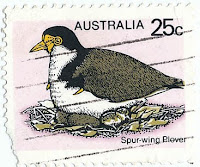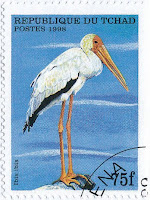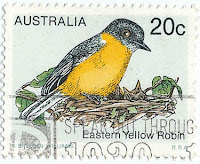Columba livia domestica
The wild rock pigeon (Columba livia) has an innate homing ability, meaning that it will generally return to its own nest and its own mate. The homing pigeon is a variety of selectively bred domestic rock pigeon. Flights as long as 1800km have been recorded by domestic birds in competition pigeon racing. Their average flying speed over moderate distances 805km is around 80km/h but speeds of up to 177km/h have been observed in top racers for short distance 160kms.
Homing pigeons are referred to as carrier pigeons when they are used to carry messages. When used as carrier pigeons, a message is written on thin light paper and rolled into a small tube attached to the bird's leg. Birds have also frequently carried microfilm. The sender of the message must release the receiver's bird as the the pigeon can only "recall" a one-way navigation.
The Egyptians and the Persians first used carrier pigeons 3,000 years ago. They also were used to proclaim the winner of the Olympics. Messenger pigeons were used as early as 1150 in Baghdad and also later by Genghis Khan. In 1860, Paul Reuter, who later founded Reuters press agency, used a fleet of over 45 pigeons to deliver news and stock prices between Brussels and Aachen, the terminals of early telegraph lines. Homing pigeons were used extensively during World War II. The Dickin Medal, which is the highest possible animal's decoration for valor, was awarded to 32 pigeons, including the United States Army Pigeon Service's G.I. Joe and the Irish pigeon Paddy. Many pigeon fanciers of that time joined the war with their own birds into the Corps of Signals Pigeon Service/Army Pigeon Service.
It is believed that the homing pigeon navigates by using a combination of mechanisms, including: detection of the earth's magnetic field, use of olfactory senses, light-mediated mechanisms involving magnetoreception, detection of infrasound to build topographical maps, and other theories including some relating to quantum physics. Various experiments suggest that different breeds of homing pigeons rely on different cues to different extents.
[All text above: Ref (143)]
Nikola Tesla, the genius behind many revolutionary inventions including AC electric power systems and radio - a communication tool relying on electromagnetic wave - was obsessed with pigeons, ordering special seeds for the pigeons he fed in Central Park and even bringing injured ones into his hotel room to nurse them back to health. He stated that pigeons were his only true friends. Tesla was said to have trialed his inventions in his mind, without drawing or sketching it first, before then successfully constructing the prototype. This extraordinary activity resonates with the the homing pigeon's inherent real-time connection with the natural-physical. [Part text: Ref (144)]
Thursday, February 10, 2011
Wednesday, February 9, 2011
Bird of Day 99: Superb Lyrebird
Menura novaehollandiae
Also known as Weringerong.
Lyrebirds are among Australia's best-known native birds, notably for their extraordinary ability to mimic natural and artificial sounds from their environment, as well as the striking beauty of the male bird's huge tail when it is fanned out in display. The Superb Lyrebird, a ground-dweller, is found in areas of rainforest in Victoria, New South Wales and south-east Queensland, as well as in Tasmania where it was introduced in the 19th century. Females are 74–84cm long, and the males are a larger 80–98cm long. There is one other species of Lyrebird - Albert's Lyrebird - smaller, less spectacular and near threatened, but otherwise similar.
Lyrebirds feed on insects, spiders, earthworms and, occasionally, seeds. They find food by scratching with their feet through the leaf-litter. When in danger, lyrebirds run, rather than fly, being awkward in flight, and have also been seen to take refuge in wombat burrows.
Male lyrebirds call mostly during winter, when they construct and maintain an open arena-mound in dense bush, on which they sing and dance in courtship, to display to potential mates, of which the male lyrebird has several. Females build an untidy nest usually low to the ground in a moist gully where she lays a single egg. She is the sole parent who incubates the egg over 50 days until it hatches, and she is also the sole carer of the lyrebird chick.
A lyrebird's call, unmatched in vocal repertoire and mimicry, is a rich mixture of its own song and any number of other sounds it has heard. The lyrebird is capable of imitating almost any sound — from a mill whistle to a cross-cut saw, and, not uncommonly, sounds as diverse as chainsaws, car engines and car alarms, fire alarms, rifle-shots, camera shutters, dogs barking, crying babies, and even the human voice. Lyrebirds are shy birds and a constant stream of bird calls coming from one place is often the only way of identifying them and their presence. Here is an excellent AV sample of the Superb Lyrebird:
http://www.youtube.com/watch?v=VjE0Kdfos4Y
Lyrebirds are ancient Australian animals: The Australian Museum has fossils of lyrebirds dating back to about 15 million years ago. The Aboriginal name for the Lyrebird is wiwieringgere. The dreamtime story of the wiwieringgere can be found here (scroll down to "Lyrebird the Mimic"): http://www.janesoceania.com/australia_aboriginal_dreamtime/index1.htm
[All text: Ref (142)]

Also known as Weringerong.
Lyrebirds are among Australia's best-known native birds, notably for their extraordinary ability to mimic natural and artificial sounds from their environment, as well as the striking beauty of the male bird's huge tail when it is fanned out in display. The Superb Lyrebird, a ground-dweller, is found in areas of rainforest in Victoria, New South Wales and south-east Queensland, as well as in Tasmania where it was introduced in the 19th century. Females are 74–84cm long, and the males are a larger 80–98cm long. There is one other species of Lyrebird - Albert's Lyrebird - smaller, less spectacular and near threatened, but otherwise similar.
Lyrebirds feed on insects, spiders, earthworms and, occasionally, seeds. They find food by scratching with their feet through the leaf-litter. When in danger, lyrebirds run, rather than fly, being awkward in flight, and have also been seen to take refuge in wombat burrows.
Male lyrebirds call mostly during winter, when they construct and maintain an open arena-mound in dense bush, on which they sing and dance in courtship, to display to potential mates, of which the male lyrebird has several. Females build an untidy nest usually low to the ground in a moist gully where she lays a single egg. She is the sole parent who incubates the egg over 50 days until it hatches, and she is also the sole carer of the lyrebird chick.
A lyrebird's call, unmatched in vocal repertoire and mimicry, is a rich mixture of its own song and any number of other sounds it has heard. The lyrebird is capable of imitating almost any sound — from a mill whistle to a cross-cut saw, and, not uncommonly, sounds as diverse as chainsaws, car engines and car alarms, fire alarms, rifle-shots, camera shutters, dogs barking, crying babies, and even the human voice. Lyrebirds are shy birds and a constant stream of bird calls coming from one place is often the only way of identifying them and their presence. Here is an excellent AV sample of the Superb Lyrebird:
http://www.youtube.com/watch?v=VjE0Kdfos4Y
Lyrebirds are ancient Australian animals: The Australian Museum has fossils of lyrebirds dating back to about 15 million years ago. The Aboriginal name for the Lyrebird is wiwieringgere. The dreamtime story of the wiwieringgere can be found here (scroll down to "Lyrebird the Mimic"): http://www.janesoceania.com/australia_aboriginal_dreamtime/index1.htm
[All text: Ref (142)]
Tuesday, February 8, 2011
Bird of Day 98: Hyacinth Macaw
Anodorhynchus hyacinthinus
Native to central and eastern South America, the Hyacinth Macaw, or Hyacinthine Macaw, is the largest macaw and the largest flying parrot species in the world, though the flightless Kakapo of New Zealand can outweigh it at up to 3.5kg. It measures 100cm long and 1.5–2kg in weight. The wingspan is 120–140cm. It prefers palm swamps, woodlands, and other semi-open wooded habitats. It usually avoids dense humid forest.
The Hyacinth Macaw is almost entirely blue and has black under the wings. Combined with the yellow circling its eyes and along the sides of its black beak, this bird is generally easily recognised.The female and male are nearly indistinguishable, although the female is typically a bit more slender.
Anodorhynchus hyacinthinus eats the kernel of hard nuts and seeds which they get to using their very strong beak. They are even able to crack coconuts, the large brazil nut pods and macadamia nuts. In addition, they eat fruits and other vegetable matter. Pine nuts are also one of the most popular foods.
These birds nest in existing holes in trees. The clutch size is one or two eggs, although usually only one fledgling survives as the second egg hatches several days after the first, and the smaller fledgling cannot compete with the first born for food. Juveniles stay with their parents until they are three months old. They are mature and begin breeding at seven years of age.
The Hyacinth Macaw is an endangered species due to overcollection for the cage bird trade and habitat loss.
[All text: Ref (141)]

Native to central and eastern South America, the Hyacinth Macaw, or Hyacinthine Macaw, is the largest macaw and the largest flying parrot species in the world, though the flightless Kakapo of New Zealand can outweigh it at up to 3.5kg. It measures 100cm long and 1.5–2kg in weight. The wingspan is 120–140cm. It prefers palm swamps, woodlands, and other semi-open wooded habitats. It usually avoids dense humid forest.
The Hyacinth Macaw is almost entirely blue and has black under the wings. Combined with the yellow circling its eyes and along the sides of its black beak, this bird is generally easily recognised.The female and male are nearly indistinguishable, although the female is typically a bit more slender.
Anodorhynchus hyacinthinus eats the kernel of hard nuts and seeds which they get to using their very strong beak. They are even able to crack coconuts, the large brazil nut pods and macadamia nuts. In addition, they eat fruits and other vegetable matter. Pine nuts are also one of the most popular foods.
These birds nest in existing holes in trees. The clutch size is one or two eggs, although usually only one fledgling survives as the second egg hatches several days after the first, and the smaller fledgling cannot compete with the first born for food. Juveniles stay with their parents until they are three months old. They are mature and begin breeding at seven years of age.
The Hyacinth Macaw is an endangered species due to overcollection for the cage bird trade and habitat loss.
[All text: Ref (141)]
Monday, February 7, 2011
Bird of Day 97: Spur-winged Plover
Vanellus miles
This bird is often called the Spur-winged Plover in its native range of Australasia, however it has been renamed Masked Lapwing to avoid confusion with the Spur-winged Lapwing/Plover of the Mediterranean and African regions (Vanellus spinosus).
Vanellus miles is a large (35cm; 370g), common and conspicuous bird native to Australia, particularly the northern and eastern parts of the continent. The subspecies found in the southern and eastern states (Vanellus miles novaehollandiae), and often locally called the Spur-winged Plover, has a black neck-stripe and smaller wattles* than its northern counterparts.
It spends most of its time on the ground searching for food such as insects and worms and has several distinctive calls. The wide range of calls can be heard at any time of the day or night include: the warning call, a loud defending call, courtship calls, calls to its young, and others. Since this bird lives on the ground it is always alert and even though it rests it never sleeps properly.
Vanellus miles will strike at interlopers with their feet and attack animals on the ground with a conspicuous yellow spur on the carpal joint of the wing. There is a much-believed but incorrect myth that the spur can inject venom.
[All text above: Ref (139)]
* A wattle is a fleshy longitudinal flap of skin hanging from various parts of the head or neck in several groups of birds, goats and other animals. [Ref (140)]

This bird is often called the Spur-winged Plover in its native range of Australasia, however it has been renamed Masked Lapwing to avoid confusion with the Spur-winged Lapwing/Plover of the Mediterranean and African regions (Vanellus spinosus).
Vanellus miles is a large (35cm; 370g), common and conspicuous bird native to Australia, particularly the northern and eastern parts of the continent. The subspecies found in the southern and eastern states (Vanellus miles novaehollandiae), and often locally called the Spur-winged Plover, has a black neck-stripe and smaller wattles* than its northern counterparts.
It spends most of its time on the ground searching for food such as insects and worms and has several distinctive calls. The wide range of calls can be heard at any time of the day or night include: the warning call, a loud defending call, courtship calls, calls to its young, and others. Since this bird lives on the ground it is always alert and even though it rests it never sleeps properly.
Vanellus miles will strike at interlopers with their feet and attack animals on the ground with a conspicuous yellow spur on the carpal joint of the wing. There is a much-believed but incorrect myth that the spur can inject venom.
[All text above: Ref (139)]
* A wattle is a fleshy longitudinal flap of skin hanging from various parts of the head or neck in several groups of birds, goats and other animals. [Ref (140)]
Sunday, February 6, 2011
Bird of Day 96: Yellow-billed Stork
Mycteria ibis 
This large protected wading bird occurs in Tropical East Africa; Zambia, Zimbabwe, and Madagascar. It lives in aquatic habitats, including shallow lakes, mud flats, coastal lagoons and meadows.
The Yellow-billed Stork is a medium-sized stork. Length: 97cm; average body weight for males: 2.3kg; for females: 1.9kg. It feeds on crustaceans, small fish, frogs, insects and worms. These birds have a quick muscular reflex of the neck, allowing almost all food to be caught in the water. They typically use one foot to stir up the water or mud which disturbs and flushes out the prey, then they submerge their heads quickly in the water snapping their bills on small prey.
Yellow-billed Storks are not particularly social, they like to isolate themselves in swamps and muddy rivers. They move slowly and deliberately and are extremely inactive, resting and feeding for most of the day. The female Yellow-billed Stork initiates courtship among the male yellow-billed storks. Together they build a bulky nest made of sticks, the male choosing where the nest is to be built. These nests are usually built high in trees away from predators.
A good photo of Mycteria ibis is here: http://www.whozoo.org/Intro2002/ShannonList/YBStorkPink041803_6537C.JPG
[All text: Ref (138)]

This large protected wading bird occurs in Tropical East Africa; Zambia, Zimbabwe, and Madagascar. It lives in aquatic habitats, including shallow lakes, mud flats, coastal lagoons and meadows.
The Yellow-billed Stork is a medium-sized stork. Length: 97cm; average body weight for males: 2.3kg; for females: 1.9kg. It feeds on crustaceans, small fish, frogs, insects and worms. These birds have a quick muscular reflex of the neck, allowing almost all food to be caught in the water. They typically use one foot to stir up the water or mud which disturbs and flushes out the prey, then they submerge their heads quickly in the water snapping their bills on small prey.
Yellow-billed Storks are not particularly social, they like to isolate themselves in swamps and muddy rivers. They move slowly and deliberately and are extremely inactive, resting and feeding for most of the day. The female Yellow-billed Stork initiates courtship among the male yellow-billed storks. Together they build a bulky nest made of sticks, the male choosing where the nest is to be built. These nests are usually built high in trees away from predators.
A good photo of Mycteria ibis is here: http://www.whozoo.org/Intro2002/ShannonList/YBStorkPink041803_6537C.JPG
[All text: Ref (138)]
Saturday, February 5, 2011
Bird of Day 95: Red-backed Kingfisher
Todiramphus pyrrhopygius 
This predominantly blue-green and white bird with a chestnut rump is found across the continent of Australia. It is a summer visitor to the southeast of the country; elsewhere it is resident all year round.
The Red-backed Kingfisher inhabits dry forests, mulga and mallee country, to savannah. It avoids denser forests. During breeding season, birds will move to river courses to make use of the earthy banks to dig nesting burrows.
Todiramphus pyrrhopygius measures 20-22.5cm in length. The male is featured here; the female has a duller overall coloration. The call is a descending whistle, with a harsh alarm call given by birds near the nest.
[All text: Ref (137)]

This predominantly blue-green and white bird with a chestnut rump is found across the continent of Australia. It is a summer visitor to the southeast of the country; elsewhere it is resident all year round.
The Red-backed Kingfisher inhabits dry forests, mulga and mallee country, to savannah. It avoids denser forests. During breeding season, birds will move to river courses to make use of the earthy banks to dig nesting burrows.
Todiramphus pyrrhopygius measures 20-22.5cm in length. The male is featured here; the female has a duller overall coloration. The call is a descending whistle, with a harsh alarm call given by birds near the nest.
[All text: Ref (137)]
Friday, February 4, 2011
Bird of Day 94: Eastern Yellow Robin
Eopsaltria australis 
The Eastern Yellow Robin is an Australasian robin of coastal and sub-coastal eastern Australia. Specifically, it occurs from the extreme southeast corner of South Australia through most of Victoria and the western half of New South Wales and north as far as Cooktown. Tropical Northern Queensland birds are mainly restricted to the cool heights of the Great Dividing Range.
At 15 to 16cm in length, the Eastern Yellow Robin is one of the larger Australasian robins, and one of the most easily observed. Eopsaltria australis occupies a wide range of habitats including heaths, mallee, acacia scrub, woodlands and sclerophyll* forests, but is most often found in damper places or near water. Like all Australian robins, the Eastern Yellow tends to inhabit fairly dark, shaded locations and is a perch and pounce hunter, typically from a tree trunk, wire, or low branch. Pairs and small family parties establish a territory—sometimes year-round, sometimes for a season—and seem little disturbed by human presence.
Their diet is a wide range of small creatures, mostly insects. Breeding takes place in the spring and, as with many Australian birds, is often communal. The nest is a neat cup made of fine plant material and spider web, usually placed in a fork, and expertly disguised with lichen, moss, bark, or leaves. They appear not to migrate any great distance, but will make local movements with the seasons, particularly to higher and lower ground.
[All text above: Ref (135)]
* Sclerophyll is a type of vegetation that has hard leaves and short internodes (the distance between leaves along the stem). [Ref (136)]

The Eastern Yellow Robin is an Australasian robin of coastal and sub-coastal eastern Australia. Specifically, it occurs from the extreme southeast corner of South Australia through most of Victoria and the western half of New South Wales and north as far as Cooktown. Tropical Northern Queensland birds are mainly restricted to the cool heights of the Great Dividing Range.
At 15 to 16cm in length, the Eastern Yellow Robin is one of the larger Australasian robins, and one of the most easily observed. Eopsaltria australis occupies a wide range of habitats including heaths, mallee, acacia scrub, woodlands and sclerophyll* forests, but is most often found in damper places or near water. Like all Australian robins, the Eastern Yellow tends to inhabit fairly dark, shaded locations and is a perch and pounce hunter, typically from a tree trunk, wire, or low branch. Pairs and small family parties establish a territory—sometimes year-round, sometimes for a season—and seem little disturbed by human presence.
Their diet is a wide range of small creatures, mostly insects. Breeding takes place in the spring and, as with many Australian birds, is often communal. The nest is a neat cup made of fine plant material and spider web, usually placed in a fork, and expertly disguised with lichen, moss, bark, or leaves. They appear not to migrate any great distance, but will make local movements with the seasons, particularly to higher and lower ground.
[All text above: Ref (135)]
* Sclerophyll is a type of vegetation that has hard leaves and short internodes (the distance between leaves along the stem). [Ref (136)]
Subscribe to:
Posts (Atom)
